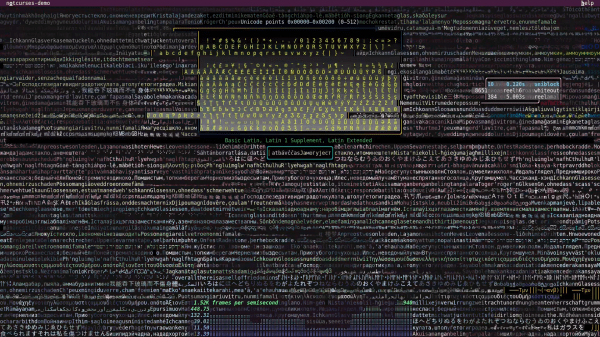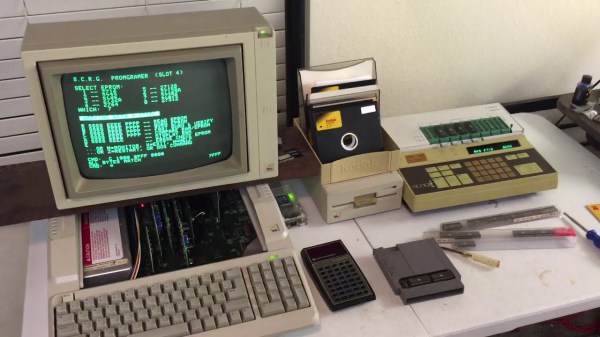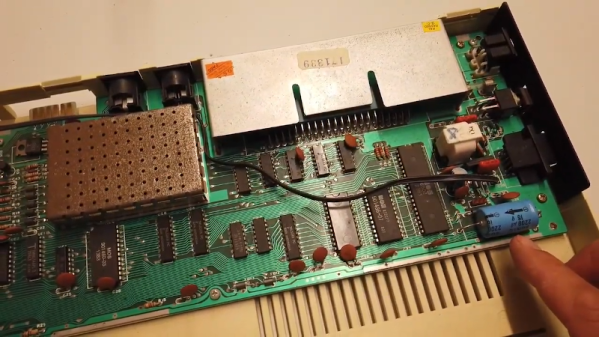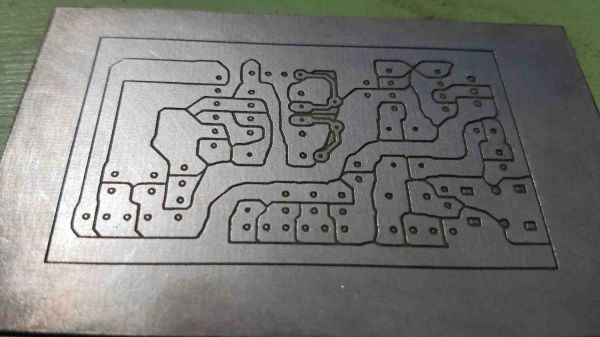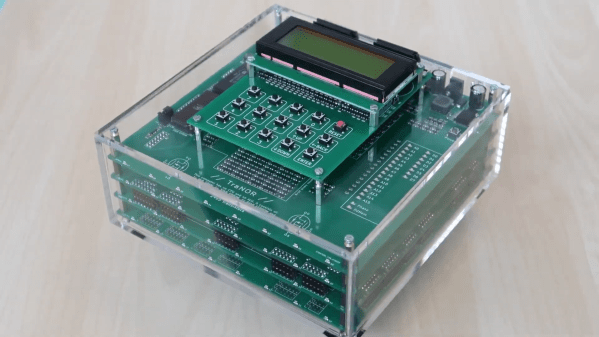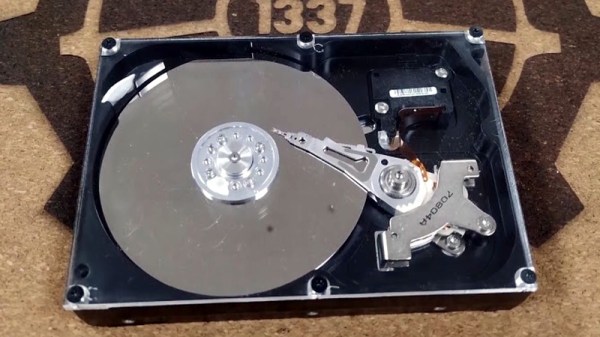Writing a command line program that needs a little more pizzaz? Ncurses just not colorful or high res enough? Or maybe you want to bring the demo scene to the command line. Notcurses has your back. The demo is great, and looks like it can push out enough detail to pull off silliness like pushing an SNES game’s output straight to the console. What might be the most impressive element of the library is that while it can blit high res graphics through a terminal emulator with graphical support, it will also work on the basic Linux console, with no graphical system installed, by using some very old tricks. I know what you’re wondering: That’s all well and good, but can it run Doom? Yep. Come back after the break for a demo.
Continue reading “Terminal Magic With Notcurses”
What NES Development Looks Like On The Apple II
These days, if you want to code a game for the original Nintendo Entertainment System, it’s about as easy as downloading an assembler, firing up Notepad, and running the ROMs you cook up in any one of a variety of emulators. In the 1980s none of those things existed, and the process was a little more complicated – as demonstrated by [Tyler Barnes] in the video embedded below.
[Tyler] has put together a 40-minute guide on what it takes to get to “Hello World” – or more accurately, a simple pink screen – on the NES, using period-correct hardware. He starts the process by formatting some floppy disks and whipping up some basic assembly code on an Apple IIe, which gets run through the Merlin assembler for the 6502. It’s particularly convenient as the Apple II line and the NES both run the same CPU. From there it’s a case of using a standalone EPROM programmer to verify some appropriately-datecoded chips are empty, before programming them in a special add-on card for the Apple II. From there, the EPROMs are loaded into a cart custom modified with chip sockets, where it can be inserted into a NES for testing.
It’s a tedious process, with just the programming side of things taking on the order of ten to twenty minutes with a few fiddly steps along the way. While there are likely some efficiency gains to be had that were used by studios back in the day, it remains clear that development in this era was a much slower process.
Of course, if you prefer your Nintendo homebrew a couple generations hence, consider getting stuck in on the Nintendo 64. Video after the break.
Continue reading “What NES Development Looks Like On The Apple II”
Inside The VIC-20
Commodore machines are well-loved around here, but usually when you think Commodore, you think about the Commodore 64, or maybe the PET or Amiga. But the Commodore 64 had an older sister, the VIC 20. This was the first computer to sell a million units and has a lot in common with its better-known successor. The machine was only made for a few years, and [Dubious Engineering] has been restoring one over a few videos. In the video below, he opens it up for a look inside, among other things.
If you want to get straight to the opening, you’ll need to fast forward about 5 and a half minutes. The keyboard pulls off and a nice old-fashioned set of cables made from individual wires connect to the skinny main board with all the smarts on it. No ribbon cables or flex PCBs!
PSA: Amazon Sidewalk Rolls Out June 8th
Whether you own any Amazon surveillance devices or not, we know how much you value your privacy. So consider this your friendly reminder that Amazon Sidewalk is going live in a few weeks, on June 8th. A rather long list of devices have this setting enabled by default, so if you haven’t done so already, here’s how to turn it off.
Don’t know what we’re talking about? Our own Jenny List covered the topic quite concretely a few months back. The idea behind it seems innocent enough on the surface — extend notoriously spotty Wi-Fi connectivity to devices on the outer bounds of the router’s reach, using Bluetooth and LoRa to talk between devices and share bandwidth. Essentially, when Amazon flips the switch in a few weeks, their entire fleet of opt-in-by-default devices will assume a kind of Borg hive-mind in that they’ll be able to share connectivity.
A comprehensive list of Sidewalk devices includes: Ring Floodlight Cam (2019), Ring Spotlight Cam Wired (2019), Ring Spotlight Cam Mount (2019), Echo (3rd Gen), Echo (4th Gen), Echo Dot (3rd Gen), Echo Dot (4th Gen), Echo Dot (3rd Gen) for Kids, Echo Dot (4th Gen) for Kids, Echo Dot with Clock (3rd Gen), Echo Dot with Clock (4th Gen), Echo Plus (1st Gen), Echo Plus (2nd Gen), Echo Show (1st Gen), Echo Show (2nd Gen), Echo Show 5, Echo Show 8, Echo Show 10, Echo Spot, Echo Studio, Echo Input, Echo Flex. — Amazon Sidewalk FAQ
Now this isn’t a private mesh network in your castle, it’s every device in the kingdom. So don’t hesitate, don’t wait, or it will be too late. Grab all your Things and opt-out if you don’t want your doorbell cam or Alexa machine on the party line. If you have the Alexa app, you can allegedly opt out on all your devices at once.
Worried that Alexa is listening to you more often than she lets on? You’re probably right.
JavaScript App Uses Advanced Math To Make PCBs Easier To Etch
We all remember the litany from various math classes we’ve taken, where frustration at a failure to understand a difficult concept bubbles over into the classic, “When am I ever going to need to know this in real life?” But as we all know, even the most esoteric mathematical concepts have applications in the real world, and failure to master them can come back to haunt you.
Take Voronoi diagrams, for example. While we don’t recall being exposed to these in any math class, it turns out that they can be quite useful in a seemingly unrelated area: converting PCB designs into easy-to-etch tessellated patterns. Voronoi diagrams are in effect a plane divided into different regions, or “cells”, each centered on a “seed” object. Each cell is the set of points that are closer to a particular seed than they are to any other seed. For PCBs the seeds can be represented by the traces; dividing the plane up into cells around those traces results in a tessellated pattern that’s easily etched.
To make this useful to PCB creators, [Craig Iannello] came up with a JavaScript application that takes an image of a PCB, tessellates the traces, and spits out G-code suitable for a laser engraver. A blank PCB covered with a layer of spray paint, the tessellated pattern is engraved into the paint, and the board is etched and drilled in the usual fashion. [Craig]’s program makes allowances for adding specific features to the board, like odd-shaped pads or traces that need specific routing.
This isn’t the first time we’ve seen Voronoi diagrams employed for PCB design, but the method looks so easy that we’d love to give it a try. It even looks as though it might work for CNC milling of boards too.
Thousands Of Discrete MOSFETs Make Up This Compact CPU-Less Computer
How long has it been since a computer could boast about the fact that it contained 2,500 transistors? Probably close to half a century now, at a guess. So in a world with a couple of billion transistors per chip, is a 2,500-transistor computer really something to brag about? Yes. Yes, it is.
The CPU-less computer, called the TraNOR by its creator [Dennis Kuschel], is an elaboration on his previous MyNOR, another CPU-less machine that used a single NOR-gate made of discrete transistors as the core of its arithmetic-logic unit (ALU). Despite its architectural simplicity, MyNOR was capable of some pretty respectable performance, and even managed to play a decent game of Tetris. TraNOR, on the other hand, is much more complicated, mainly due to the fact that instead of relying on 74HC-series chips, [Dennis] built every single gate on the machine from discrete MOSFETs. The only chips on the four stacked PCBs are a trio of memory chips; we don’t fault him at all for the decision not to build the memory — he may be dedicated, but even art has its limits. And TraNOR is indeed a work of art — the video below shows the beautiful board layouts, with seemingly endless arrays of SMD transistors all neatly arranged and carefully soldered. And extra points for using Wintergatan’s marble machine melody as the soundtrack, too.
As much as we loved the original, TraNOR is really something special. Not only is it beautiful, but it’s functional — it’s even backward-compatible with MyNOR’s custom software. Hats off to [Dennis] for pulling off another wonderful build, and for sharing it with us.
Continue reading “Thousands Of Discrete MOSFETs Make Up This Compact CPU-Less Computer”
Transparent Hard Drive Gives Peek At The Platters
Solid-state drives (SSDs) are all the rage these days, and for good reason. But that doesn’t mean the era of the spinning disk is over, as traditional mechanical hard drives still offer a compelling value for mass storage applications where access times aren’t as critical. But the components inside these “slow” mechanical drives are still moving at incredible speeds, which [The Developer Guy] has nicely illustrated with his transparent hard drive.
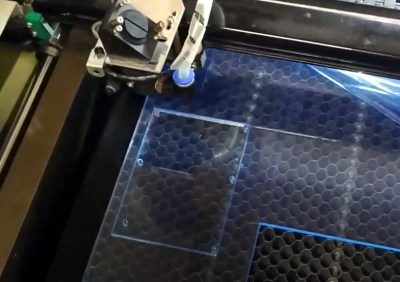 Now unfortunately the technology to produce a fully transparent hard drive doesn’t exist, but laser cutting a new top plate out of acrylic is certainly within the means of the average hacker. The process is pretty straightforward: cut out a piece of clear plastic in the same shape and size as the drive’s original lid, put the appropriate mounting holes in it, and find some longer screws to accommodate the increased thickness.
Now unfortunately the technology to produce a fully transparent hard drive doesn’t exist, but laser cutting a new top plate out of acrylic is certainly within the means of the average hacker. The process is pretty straightforward: cut out a piece of clear plastic in the same shape and size as the drive’s original lid, put the appropriate mounting holes in it, and find some longer screws to accommodate the increased thickness.
Because this is just for a demonstration, [The Developer Guy] doesn’t need to worry too much about dust or debris getting on the platters; but we should note that performing this kind of modification on a drive you intend on actually using would be a bad idea unless you’ve got a cleanroom to work in.
In the videos below [The Developer Guy] records the drive while it’s in use, and at one point puts a microscope on top of the plastic to get a close-up view of the read/write head twitching back and forth. We particularly liked the time-lapse of the drive being formatted, as you can see the arm smoothly moving towards the center of the drive. Unfortunately the movement of the platters themselves is very difficult to perceive given their remarkably uniform surface, but make no mistake, they’re spinning at several thousand RPM.
Have an old mechanical drive of your own that you’re not sure what to do with? We’ve seen them turned into POV clocks, impromptu rotary encoders, and even surprisingly powerful blower fans.
Continue reading “Transparent Hard Drive Gives Peek At The Platters”

